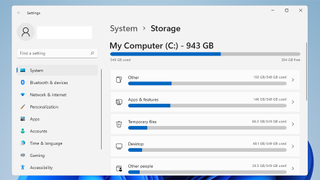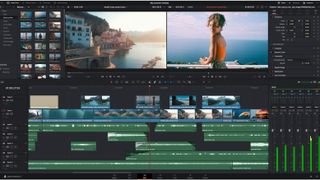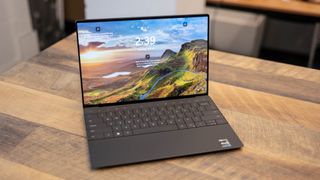How much storage do I need on my laptop?
Is a terabyte enough? Too much?

Part of finding the best laptop for you is answering the question, “How much storage do I need on my laptop?” Storage space refers to your computer’s capacity for storing files and data. The more storage space you have, the more documents, images, or files your PC can hold, and the faster it can recall them when needed. More is almost always better, but it’s about balancing want versus need, price versus impact.
Before deciding on how much storage is appropriate, consider your usual activities. A video editor, for example, might measure most of their files in dozens to hundreds of gigabytes, while the average user – someone who spends most of their time on the web – could get by with much less.
And when we think about price, there are additional questions to consider. Can we get by with an HDD, or do we need the speed of an SSD? Equivalent SSD storage space could be three to four times more expensive, but the speed increase could be worth it depending on your needs.
As you can see, determining just how much space you need on your laptop isn’t as simple as it may seem, but we’re here to help.
Things to consider for your laptop storage
When buying a new laptop, we generally have a storage figure in mind. We typically overestimate our needs when deciding on specs in a new machine, so just taking a guess isn’t wrong, but you might end up overpaying. Here are .the most important factors to keep in mind.

Your typical laptop use
For the average user, a laptop is primarily a device to send email, browse the web, watch streaming content, and converse on social media. Most prefer web-based applications, like Google Docs, as opposed to applications they need to download and install. Combined with cloud-based storage like iCloud or Google Drive and streaming platforms like YouTube, Netflix, and Spotify for entertainment and it’s easy how many users could get by with minimal storage space.
Compare that to a video editor, photographer, or coder. These users require more performance and more space. Video editors, for example, need to quickly store and recall hundreds of gigabytes, or even a few terabytes, of information. The ability to import and export large files with minimal wait times is crucial and requires a lot of SSD space.
Stay in the know with Laptop Mag
Get our in-depth reviews, helpful tips, great deals, and the biggest news stories delivered to your inbox.
Only you will know the answer to where you reside on that spectrum, so first do an honest accounting of your primary activities on your laptop and whether they take up a considerable amount of storage space.

Your budget
If money is no object then you can ignore this, but as storage is one of the more expensive upgrades you can make on a laptop this can swing the price considerably. HDDs offer more storage at a cheaper price than SSDs, but with significantly slower read and write speeds, meaning it takes longer to save or retrieve files from the drive.
The average HDD, for example, costs around $0.04 per gigabyte as of this writing. SSDs, on the other hand, cost about $0.25 per gigabyte. On average, a terabyte of storage on each would cost $40 for the HDD and $250 for the SSD.
HDDs offer a lot of bang for the buck, so we’re not suggesting anyone skip them. What could be a more reasonable solution, though, especially for the budget-conscious, is to buy a laptop with a smaller SSD that will cover your day-to-day storage needs and get an external HDD for archiving content you want to save, but don’t always need to access. This solves both needs, giving you a lot of space but speed for the things you use most often.

Purge intervals
You need to consider what you need today and how quickly you’re accumulating new files – photos and videos, for example – to project your needs for the future.
While upgrading from 512GB to a terabyte sounds like a massive jump, you could quickly eat away at available storage space once you start importing your files and downloading new apps and games. If you’re a digital pack rat who doesn’t regularly purge unneeded files, you could be back where you started in just a few weeks or months.
For these considerations, consider what you need today and how quickly you accumulate new files. This should give you a rough estimate of how long it would take you to fill your storage and how aggressive you should purge files to keep up.

The types of files you’re storing (and where you’re storing them)
A casual user can make use of cloud-based storage for almost everything. We still recommend regular offline backups for your most vital files, but with a reliable fast internet connection cloud storage covers most of your needs.
Most users' storage needs come down to photos, videos, applications, and games, so consider how you’re storing each. Google Drive and iCloud are affordable solutions to store photos and videos. Using these services means you’ll need less physical space on your laptop.
Gamers can rely on services like Steam to store games they own, but haven’t played in a while. Steam saves a copy of the game and you can download it any time from a convenient dashboard. Unused games get deleted from your device and re-downloaded when you’re ready to play.
A power user, conversely, needs physical storage. An industrial designer, for example, can’t wait minutes (or hours) for a massive CAD file to download when presenting it to a client. An architect can’t rely on cloud storage alone to store thousands of man hours of architectural renderings and engineering blueprints. Video editors don’t have time to import and export 250 gigabytes of b-roll for a documentary they’re working on.
For these users, physical storage is a must. For the rest of us, it’s mostly a nice-to-have.

So how much storage do I need on my laptop?
512 gigabytes is the sweet spot for most users. And by most, we’re talking about greater than 80% of PC owners. If you want something a little more future-proof, opt for a terabyte and you should be more than happy.
Power users are a different story entirely. There’s really no right answer here other than to say most should start with a terabyte or more. You will want that much space on your laptop to benefit from the premium internal SSDs that come in the best video editing laptops. Top end MacBooks that are the favorites of some video editors go all the way up to 8TB of storage, but that gets really expensive. Even for power users, the best answer is to choose a laptop SSD that will cover your day-to-day needs and then look at some of the best portable SSDs for content creators for added external storage that won’t slow you down.
